


In today’s competitive world, enterprises around the world are investing large sum of money and resources in developing a software and application that has a universal appeal and are culturally as well as linguistically appropriate. Moreover, they validating the quality and functionality of the software product with the assistance of two testing techniques - globalization testing and localization testing and try to make sure that their products deliver services that are appropriate for a particular region, locale, culture, etc. Hence, to help you differentiate these testing techniques, here is a comparison of localization and globalization testing.
The similarities between Localization Testing and Globalization Testing are quite a few, however the differences of these two testing techniques are numerous, which are discussed in detail below:
Localization Testing or L10N is an important testing technique, wherein the software and applications are customized for a given culture and locale. During this process testers make sure that the features, content, and other relevant components of the software are region and linguistic specific.
On the other hand, globalization testing/G11N is process of validating the quality and functionality of the software product, while ensuring it offers services suitable for multiple cultures, countries, areas, and geographical regions.
The purpose of Localization Testing is to explore the defects and gaps in the software, which can impact the proper functioning of the user interface, linguistic translation and features, etc., along with their settings. Additionally, it is performed to examine the standard of the product for a particular locale or culture.
Globalization Testing is executed to detect issues and loopholes in the software, which hinder the globalization as well as the quality of the product. It also manages and handles various international support without affecting the functioning and performance. Furthermore, it ensures that the software adapts various geographical changes easily and validates its universal appeal and performance.
The characteristics of localization testing and globalization testing are:
The parameters covered by localization testing include language, time-format, currency, display appearance, font-scripting, resource translation, content & UI, functionality and features of a local version of the software product, for a particular country.
Whereas, globalization testing encompasses language & vocabulary, layout of date format and time notation, currency format, conversion rates handling, phone number, address, zip code, font scripting, etc. for multiple locations and countries.
The advantages offered by localization testing and globalization testing are uncountable, some of which are mentioned below:
Cultural sensitivity, linguistic appropriateness, and software’s global as well as locale appeal are some of the most important characteristics of a software that are validated by globalization testing and localization testing. These components play a major role in making the software suitable for the global as well as local audience and assist in increasing the popularity of the software. With the assistance of globalization testing and localization testing the team takes necessary measures to improve the quality, functionality, performance, and other important elements of the software. In short, without implementing these two testing techniques, software engineers cannot develop a quality software product that meets the requirements of the target audience and market.
Advertisement: